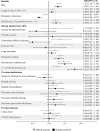Rehospitalization for pneumonia after first pneumonia admission: Incidence and predictors in a population-based cohort study
- PMID: 32603334
- PMCID: PMC7326167
- DOI: 10.1371/journal.pone.0235468
Rehospitalization for pneumonia after first pneumonia admission: Incidence and predictors in a population-based cohort study
Abstract
Background and objectives: Hospital readmissions are a frequent complication of pneumonia. Most data regarding readmissions are obtained from the United States, whereas few data are available from the European healthcare utilization (HCU) systems. In a large cohort of Italian patients with a previous hospitalization for pneumonia, our aim was to evaluate the incidence and predictors of early readmissions due to pneumonia.
Methods: This is a observational retrospective, population based, cohort study. Data were retrieved from the HCU databases of the Italian Lombardy region. 203,768 patients were hospitalized for pneumonia between 2003 and 2012. The outcome was the first rehospitalization for pneumonia. The patients were followed up after the index hospital admission to estimate the hazard ratio, and relative 95% confidence interval, of the outcome associated with the risk factors that we had identified.
Results: 7,275 patients (3.6%) had an early pneumonia readmission. Male gender, age ≥70 years, length of stay of the first admission and a higher burden of comorbidities were significantly associated with the outcome. Chronic use of antidepressants, antiarrhythmics, glucocorticoids and drugs for obstructive airway diseases were also more frequently prescribed in patients requiring rehospitalization. Previous use of inhaled broncodilators, including both beta2-agonists and anticholinergics, but not inhaled steroids, were associated with an increased risk of hospital readmission.
Conclusions: Frail elderly patients with multiple comorbidities and complex drug regimens were at higher risk of early rehospitalization and, thus, may require closer follow-up and prevention strategies.
Conflict of interest statement
The authors have read the journal's policy and the authors of this manuscript have the following competing interests: G.C. received research support from the European Community (EC), the Italian Medicines Agency (AIFA), and the Italian Ministry of Education, Universities and Research (MIUR). He took part in a variety of projects that were funded by pharmaceutical companies (Novartis, GSK, Roche, AMGEN and BMS). He also received honoraria as a member of the Advisory Board of Roche. No other potential conflicts of interest were declared. This does not alter our adherence to PLOS ONE policies on sharing data and materials.
Figures



Similar articles
-
Hospital readmissions of elderly patients hospitalized with pneumonia.Conn Med. 2003 Nov-Dec;67(10):599-603. Conn Med. 2003. PMID: 14677340
-
Predictors of rehospitalization among elderly patients admitted to a rehabilitation hospital: the role of polypharmacy, functional status, and length of stay.J Am Med Dir Assoc. 2013 Oct;14(10):761-7. doi: 10.1016/j.jamda.2013.03.013. Epub 2013 May 7. J Am Med Dir Assoc. 2013. PMID: 23664484 Free PMC article.
-
Predictors of short-term rehospitalization following discharge of patients hospitalized with community-acquired pneumonia.Chest. 2009 Oct;136(4):1079-1085. doi: 10.1378/chest.08-2950. Epub 2009 Apr 24. Chest. 2009. PMID: 19395580
-
Age-Related Differences in the Rate, Timing, and Diagnosis of 30-Day Readmissions in Hospitalized Adults With Asthma Exacerbation.Chest. 2016 Apr;149(4):1021-9. doi: 10.1016/j.chest.2015.12.039. Epub 2016 Jan 21. Chest. 2016. PMID: 26836926 Free PMC article.
-
The crucial factor of hospital readmissions: a retrospective cohort study of patients evaluated in the emergency department and admitted to the department of medicine of a general hospital in Italy.Eur J Med Res. 2015 Jan 27;20(1):6. doi: 10.1186/s40001-014-0081-5. Eur J Med Res. 2015. PMID: 25623952 Free PMC article.
Cited by
-
Polypharmacy Management in Chronic Conditions: A Systematic Literature Review of Italian Interventions.J Clin Med. 2024 Jun 17;13(12):3529. doi: 10.3390/jcm13123529. J Clin Med. 2024. PMID: 38930058 Free PMC article. Review.
-
Investigation of drug-related problems in patients hospitalized in chest disease wards: A randomized controlled trial.Front Pharmacol. 2023 Jan 10;13:1049289. doi: 10.3389/fphar.2022.1049289. eCollection 2022. Front Pharmacol. 2023. PMID: 36703759 Free PMC article.
-
Effect of Anemia on Readmission and Death in Octogenarian Patients with Lower Respiratory Tract Infections: A Retrospective Cohort Study.Int J Clin Pract. 2022 Oct 27;2022:4566936. doi: 10.1155/2022/4566936. eCollection 2022. Int J Clin Pract. 2022. PMID: 36349057 Free PMC article.
-
Risk factors for hospital readmissions in pneumonia patients: A systematic review and meta-analysis.World J Clin Cases. 2022 Apr 26;10(12):3787-3800. doi: 10.12998/wjcc.v10.i12.3787. World J Clin Cases. 2022. PMID: 35647168 Free PMC article.
-
Disease Severity and Risk Factors of 30-Day Hospital Readmission in Pediatric Hospitalizations for Pneumonia.J Clin Med. 2022 Feb 23;11(5):1185. doi: 10.3390/jcm11051185. J Clin Med. 2022. PMID: 35268277 Free PMC article.
References
Publication types
MeSH terms
LinkOut - more resources
Full Text Sources
Medical

